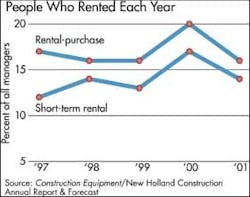Renting equipment has become so common that it's hard to overlook. But gathering anecdotes by driving by construction sites hardly makes anyone an expert on rental choices.
The growing population of machines in rental fleets suggests that renters are exercising the option more often. When you ask people about how they prefer to put machines to work, however, you discover some interesting things about how renting fits into the scheme of acquiring horsepower that includes buying new, buying used, or leasing machines. Ten observations noted here are drawn primarily from the results of a Construction Equipment study that did just that. The research addressed how equipment managers usually choose to acquire various kinds of machines.
We hope this sample of results challenges enough of the assumptions that might arise from drive-by impressions that you'll consider all the alternatives the next time you're looking for equipment to put to work.
Renters Steady, Rentals RisingThe percentage of fleet managers who rented equipment soared in 2000, when most of the industry was surprised with more work volume than forecast for the year. But by 2001, the percentage of those who rented dropped back to 1999 levels, where it had been holding steady since 1997.Obviously, regular renters are renting more machines, though. Pieces of equipment in rental fleets across the United States increased 24 percent to nearly 60,000 units between 1995 and 1999 (the last time the Universe of Construction Equipment study was compiled).Renting pavers is nearly as popular as buying used




